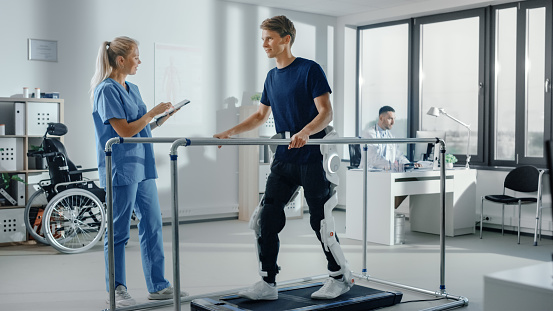The advancement of technology in physiotherapy is not limited to the clinic. It has also helped patients complete their therapy outside the clinic. As a result, patients are more likely to recover from injuries and chronic conditions and live healthier lives. The use of technology in physiotherapy includes the use of robotics, AI, and telemedicine.
Physiotherapy technology
Physiotherapy technology has become increasingly advanced as medical technology has evolved. Newer treatment methods include therapeutic ultrasound, which treats conditions like frozen shoulders and tight joints. Electrical muscle stimulation, or TENS, helps to rebuild muscle strength. These newer techniques are less expensive and smaller than earlier devices.
Digital technology has also helped to make physiotherapists more accessible to patients. Using a computer, internet connection, and an app, a physiotherapist can consult with a patient from the comfort of their home. With the right tools, physiotherapists can accurately assess a patient’s condition and develop a custom treatment plan for the patient.
Physiotherapy technology has also made assessing a patient’s fitness easier. There are now underwater treadmills and other innovative technologies that allow physiotherapists to provide resistance training.
Robotics
Robotics has been a growing part of the physiotherapy industry for the past decade. These devices are an increasingly effective way to help people regain upper and lower limb function. They can also help with motor relearning and cognitive functions, such as attention and proprioception. However, they are not substitutes for physiotherapists. The main goal of rehabilitation robotics is to improve a patient’s function in a shorter period.
Robotics improve the range of motion and reduce joint impedance. They can also be programmed to apply precise amounts of force to affected joints. Continuous passive motion machines are already common in rehabilitation, but robots can help patients improve their range of motion much faster.
Robotics is also becoming a part of rehabilitation trials. Some clinics are already testing rehabilitation robotics, and many wish to have them for their patients. The ability to remotely control robotics in rehabilitation has many advantages, including repeating exercises as many times as needed and measuring patients’ progress.
AI
Artificial intelligence (AI) is a major advancement in physiotherapy, but it is far from a magic bullet. In the near future, clinicians will have to deal with huge data networks and interpret complex interactions. This change will significantly affect physiotherapy education and practice. To prepare for this new era, physiotherapists should be prepared to undergo a radical overhaul in their education.
AI is already used in healthcare settings to improve diagnosis, management, and preparation. It has also facilitated the development of expert systems for clinical decision-making. This technology also advances image recognition, physical manipulation, information processing, and reasoning. A physiotherapist can spend less time writing clinical notes and more time on patient-reported outcomes. AI can also provide easy-access guidelines for clinical practice, facilitating the application of research in practice.
Another benefit of AI in physiotherapy is that it allows patients to view their movements on a screen rather than physically assessing their progress. By allowing patients to see how far they have come, AI devices can be used to help patients complete exercises more efficiently. Neural networks will be able to detect improper patterns and adjust their output based on feedback from patients.
Telemedicine
Telemedicine is an excellent option for healthcare providers who want to extend their reach and improve quality of care. It can also improve access to care for underserved populations. Because many low-income populations do not have access to a physician, telemedicine can help these patients access care without needing to travel.
In addition to reducing travel time and costs, telehealth from Physio Inq allows for continuous care and real-time feedback. It can help therapists and patients target specific pain points and reduce overlooked problems that slow recovery. For example, illness or travel plans can stall PT sessions. Moreover, this can lead to missed sessions, affecting patient progress.
Telehealth physical therapy is a rapidly growing trend. It allows patients to have online appointments with a physical therapist from their homes. These virtual appointments can also be used for diagnosing and providing health-related information. By providing remote care, telehealth physiotherapists can save both time and resources.


Leave a Reply